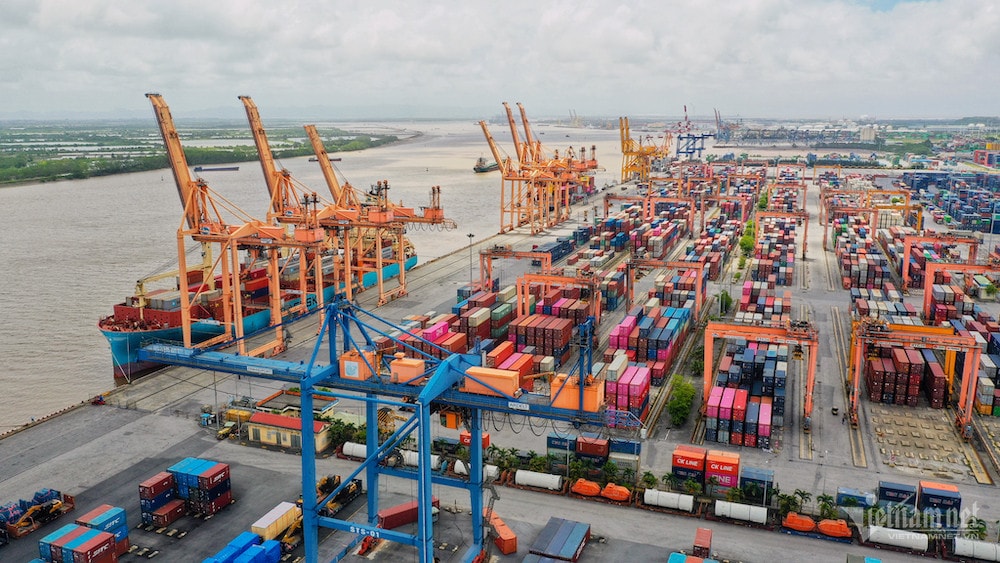Despite the advantage of seaports, the domestic logistics sector, especially in the Southeast region, still has many bottlenecks. Meanwhile, Laos and Cambodia are investing heavily in this sector.

The Southeast region currently has nearly 18,000 businesses registered to operate in the logistics sector, accounting for 46% of the total number of logistics businesses and handling 45% of the total volume of goods nationwide.
However, at the "Forum on Linking Logistics Development - Driving Force for Economic Growth in the Southeast Region", organized by the People's Committee of Ba Ria - Vung Tau Province and the Vietnam Federation of Commerce and Industry (VCCI) on the afternoon of September 8, Mr. Dang Vu Thanh, Vice President of the Vietnam Logistics Service Enterprises Association, said that the regional logistics industry still faces problems related to synchronization.
For example, Mr. Thanh is working at a logistics service company, the company has a port in Ho Chi Minh City, opposite is a port in Dong Nai and next to it is a port in Binh Duong province.
However, the fee policies between the three ports are different. Ho Chi Minh City collects infrastructure fees, while Dong Nai and Binh Duong do not. Thus, there is a gap in the policy story, which affects the logistics industry market.
Mr. Pham Tan Cong, Chairman of VCCI, said that logistics enterprises have invested quite well in infrastructure and technology. However, they cannot connect infrastructure between provinces and cities in the region, between production and processing zones, industrial zones with ports, airports, and between regions and markets.
Deputy Director of the Import-Export Department (Ministry of Industry and Trade), Mr. Tran Thanh Hai gave the example of Laos and Cambodia, these neighboring countries are making great efforts in investing to promote logistics.
For example, Laos is a landlocked country, which is a logistics lowland. However, the change in Laos is evident when they have a railway connecting to China. It becomes the central railway of Southeast Asia, in the future connecting to Thailand, towards the sea, making Laos a logistics center of the region.
Meanwhile, Cambodia has a large volume of transit goods at ports in the Southeast region. However, the neighboring country is promoting the exploitation of Sihanoukville port and other waterways to become self-sufficient in logistics and freight transport.
"Vietnam has a frontage on the East Sea. If it does not take advantage of these factors, it will lose all its advantages in the logistics industry. The same goes for the seaport area of Ba Ria - Vung Tau province," Mr. Hai noted.
On the local side, Mr. Nguyen Van Tho, Chairman of the People's Committee of Ba Ria - Vung Tau province, admitted that the development level of logistics services in the locality has not yet met the requirements of an important center for maritime transport and multimodal transport.
For example, the system of warehouse services and logistics centers after the port has not kept up with the trend; there is a lack of logistics services... These are bottlenecks that the province needs to find solutions to soon remove.
In the future, the transportation and logistics services industry in Ba Ria - Vung Tau will grow strongly with the formation of important traffic routes connecting the Southeast and Southwest regions. When completed, Long Thanh International Airport to Ba Ria - Vung Tau is only about 30km.
According to the provincial chairman, the locality aims to develop the area along Cai Mep - Thi Vai river to Bien Hoa - Vung Tau expressway - Ring Road 4 into an industrial - service - seaport urban area, focusing on logistics centers, free trade zones, dry ports providing warehouse transportation services associated with the Cai Mep - Thi Vai port system and Long Thanh international airport.
According to Vietnamnet